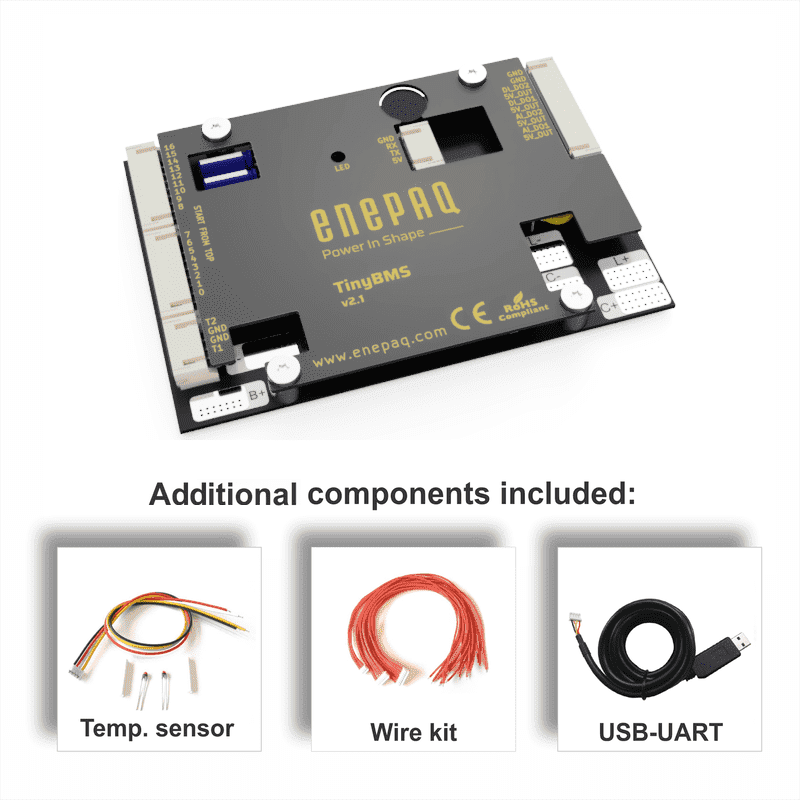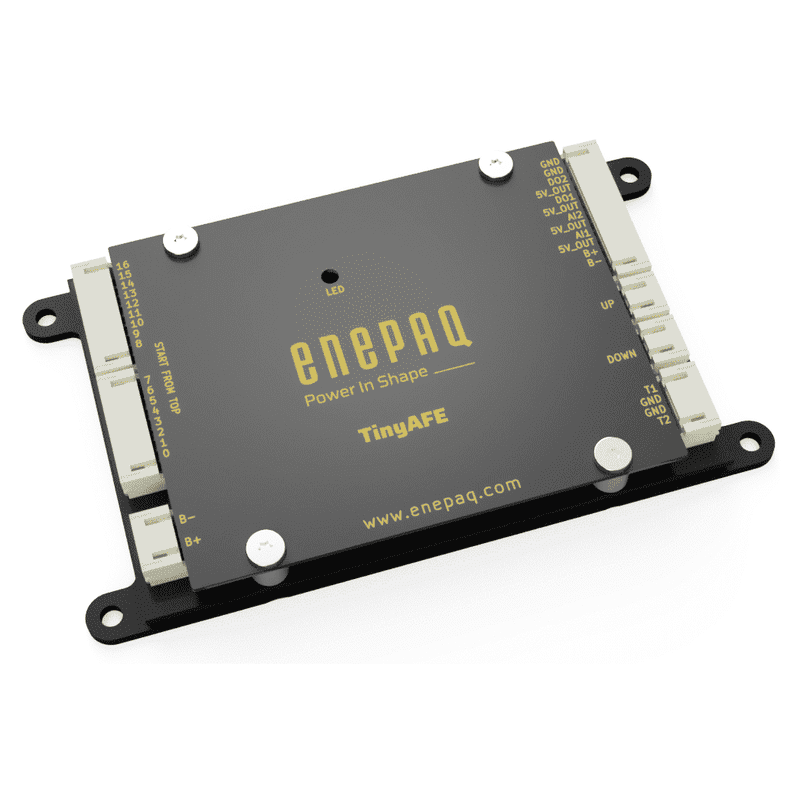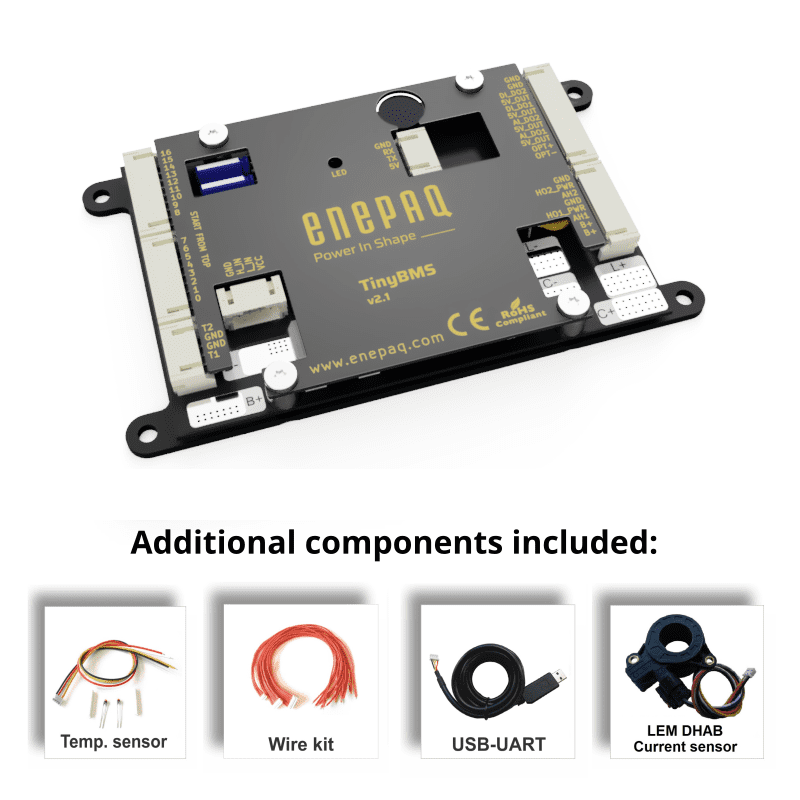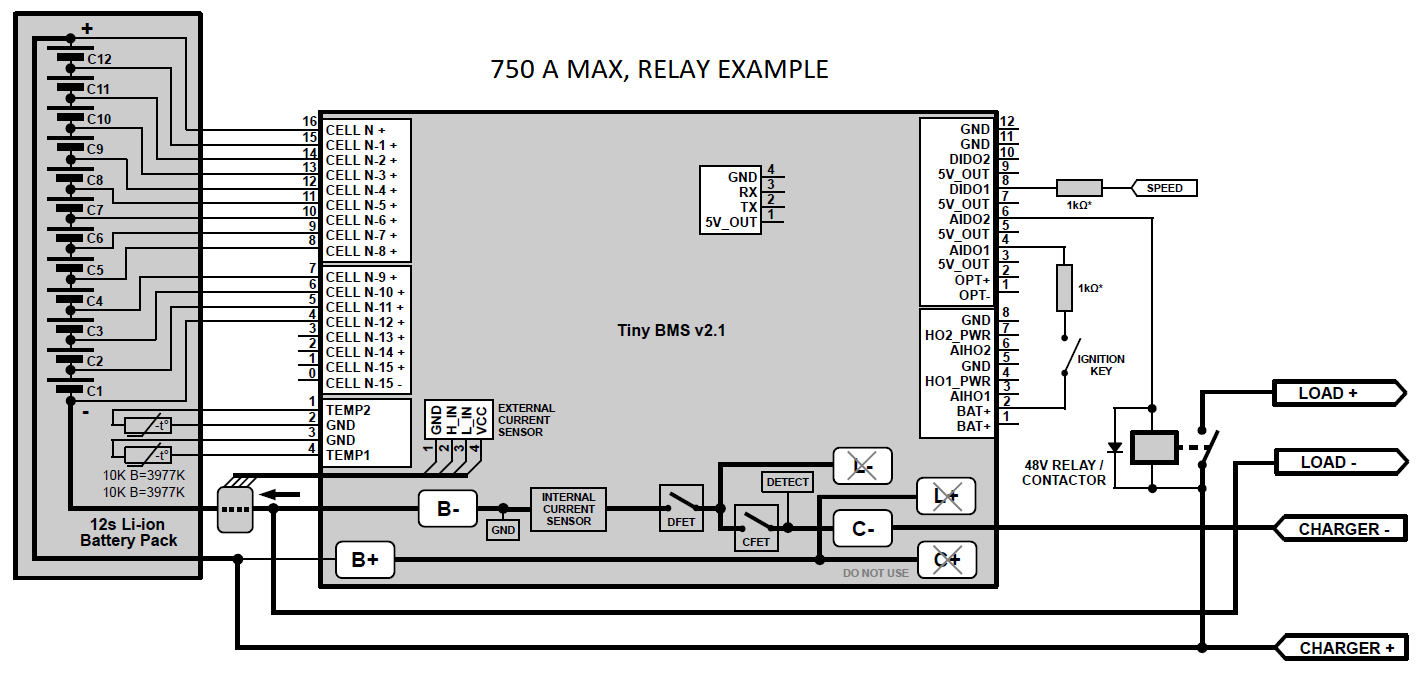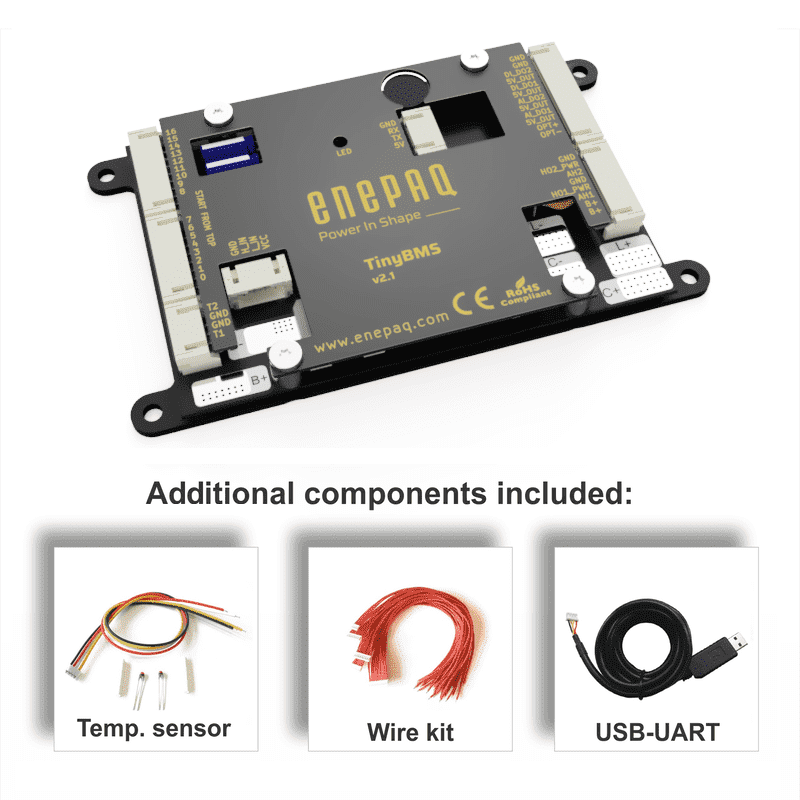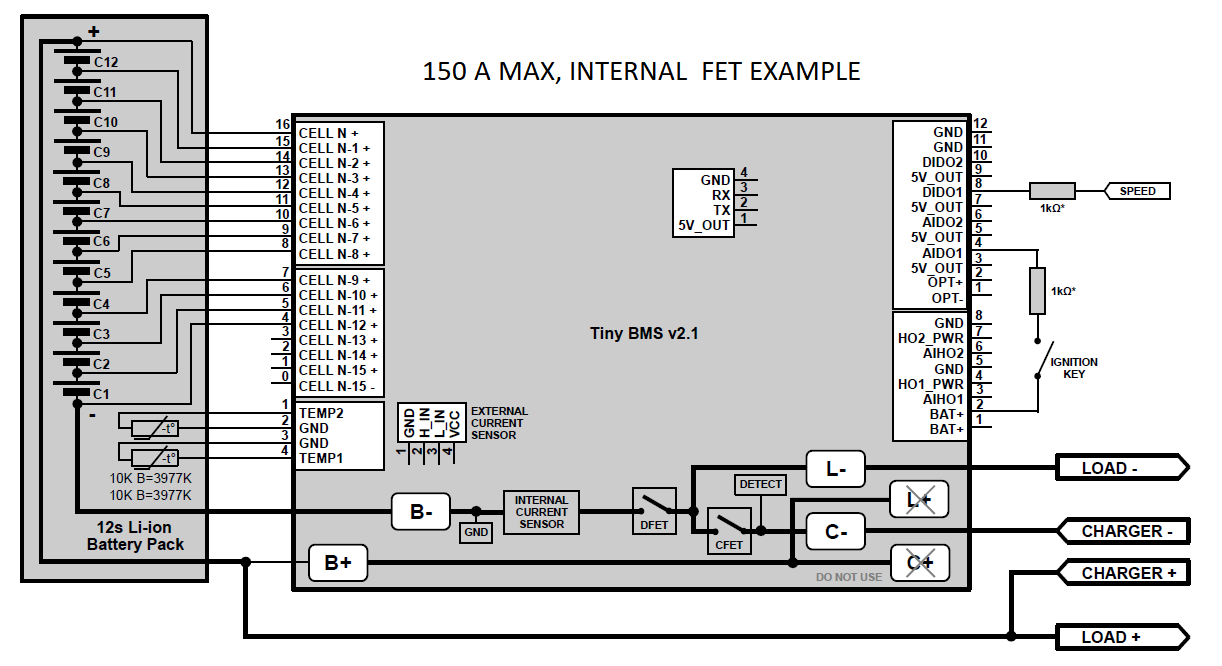Description
Customizable Battery Management System: Tiny BMS s516 (30A Peak Discharge)
Battery Management System (BMS) 30A – The Tiny BMS is an essential component for every Lithium battery. Enepaq Tiny BMS supports lithium batteries of any chemistry and up to 60 V nominal. Battery capacity from sub-1 Ah to 655 Ah can be managed easily. Tiny BMS measures individual voltages of parallel cell groups and manages the switching of load and charger. During charging, cells are balanced by bleeding off higher cells to accomplish full balance and maintain good health of the battery pack. State-of-Charge is calculated as well, and is available via communication bus to be displayed for the user.
Safe and Secure Battery Connection
For safe and reliable operation, it’s crucial to follow the correct sequence when connecting the Tiny BMS s516 to your battery pack. Improper connection can damage both the battery and the BMS. For detailed instructions, please refer to the Tiny BMS s516 manual on page 12, paragraph 2.3.2, Tiny BMS battery pack connection sequence. This section outlines the step-by-step process for safe battery pack connection.
Smart Battery Management System (BMS) Key Features:
Low-Current Handling: Manage battery packs with discharge currents up to 30A (peak) and sustained currents of 15A, making it suitable for moderate-power applications.
Advanced Cell Management:
- Monitor individual cell voltages of 4 to 16 series-connected Lithium-ion cells (4s-16s).
- Balance cells to maintain equal charge levels and prolong battery life through dissipative balancing up to 150 mA.
Comprehensive Protection:
- Voltage and Current Cutoff Protection: Disconnects the battery to prevent over-charging or over-discharging through programmable voltage thresholds.
- Battery Pack Thermal Management: Monitors battery temperature and can be configured to take corrective actions, such as reducing charge or discharge current, to prevent overheating. Shuts down the battery pack if it exceeds user-defined temperature limits measured by internal or external sensors (supports up to two external temperature sensors).
- Automatic Recovery: Recovers from warning or fault states after a timeout period or manual intervention.
Highly Customizable BMS Solution:
- Tailor-made Solutions: Our company provides firmware and hardware customization to perfectly align with your unique project requirements.
- Integrated Power Management: Built-in power switches streamline system design.
- Flexible Connectivity: Supports various communication protocols including UART, MODBUS, CAN, and Bluetooth for easy integration.
- Wide Range Compatibility: Works with 12V to 60V battery systems (4s-16s) and all lithium chemistries.
- Adjustable Parameters: Fine-tune voltage, current, and temperature settings for optimal performance.
Advanced Features:
- Dissipative Balancing up to 150 mA.
- Supports up to two external temperature sensors and one dual-range current sensor.
- Event Log and Usage Statistics for in-depth analysis.
- Free Firmware Upgrades to ensure your BMS stays up-to-date.
- Programmable Inputs and Outputs for expanded functionality.
- Compact Design: Ultra-compact design (95x65x9 mm and only 97g) maximizes space efficiency in your application.
- Current Sensor Connection: Simplifies integration with external current sensors.
Battery Insider Software for Superior BMS Monitoring and Control:
The Tiny BMS s516 is paired with the Battery Insider software, a user-friendly interface that provides comprehensive configuration and monitoring capabilities:
Configuration:
- Define cell settings (voltage thresholds, balancing).
- Set discharge and charge current limits.
- Program temperature protection.
- Configure automatic recovery settings.
- Select BMS operation mode (single port/dual port).
- Manage external components (charger, load, contactor, temperature sensors).
Real-time Monitoring: View critical battery parameters like cell voltages, currents, temperatures, and state of charge.
Data Analysis:
- Event Logging: Track BMS events and diagnose potential issues.
- Lifetime Statistics: Gain insights into battery usage patterns.
- Data Logging: Perform detailed analysis of BMS behavior.
- Firmware Updates: Keep your BMS up-to-date with the latest firmware.
Benefits:
- Protects Lithium-ion batteries from damage caused by over-charging, over-discharging, excessive current, and temperature extremes.
- Extends battery life through cell balancing and improved safety features.
- Enables informed maintenance decisions through comprehensive battery parameter monitoring.
- Provides advanced data analysis for troubleshooting and performance optimization.
- Offers user-friendly software for easy configuration and management of the low-current BMS.
- Highly Customizable: Tailor the BMS to your specific project needs with firmware and hardware customization options.
Overall, the Tiny BMS s516 with Battery Insider software is a comprehensive and customizable solution for moderate-current Lithium-ion and LiFePO4 battery management, offering a high degree of control, protection, and monitoring capabilities for demanding applications.
Views: 9300
BMS Insider Software
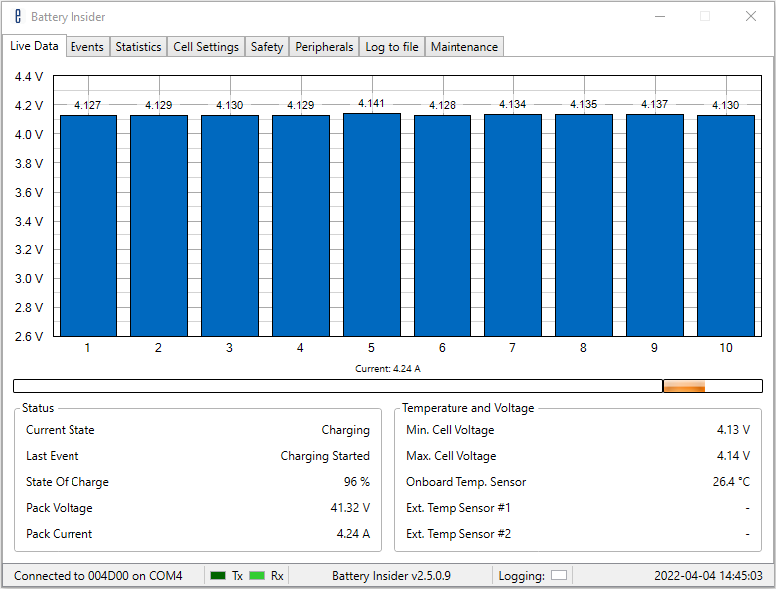
Smart Battery Management system (BMS) 30A – ‘Tiny BMS s516’ Battery Insider Windows application suggests a user-friendly graphical interface for settings and monitoring and can be configured using two methods:
- UART, MODBUS or CAN communication commands: This indicates flexibility for integration with existing industrial systems through text-based protocols.
- Battery Insider Software Features: The Battery Insider software offers a comprehensive suite of features for monitoring and managing the Tiny BMS s516, including:
- Live Data: Real-time monitoring of various battery parameters like individual cell voltages, charging/discharging current, battery pack voltage, and temperature.
- Cell Balancing: The software can identify cells undergoing balancing and visualize their status.
- State-of-Charge (SoC): Estimation of the remaining battery capacity.
- Event Logging: Recording of BMS events for troubleshooting and analysis.
- Communication Status: Monitoring of the communication health between the BMS and the software.
- Data Logging: Ability to log BMS data for further analysis.
- NTC Temperature Monitoring: Monitoring of internal and external battery pack temperatures (up to 2 sensors).
- Event Monitoring: The Battery Insider software provides a dedicated tab for viewing a list of BMS events.
- Event Types: The BMS can record different types of events, including:
- Informational events (likely for notification purposes)
- Warning events (indicating potential issues)
- Fault events (indicating critical problems)
- Event Details: Each event record likely includes:
- Timestamp
- Description of the event
- HEX code (possibly for advanced users or diagnostics)
- Event Clearing: A “Clear Events” button allows users to clear the event log from the BMS’s internal memory. However, it’s important to note that this does not necessarily clear the warning or fault condition itself.
- BMS Recovery: The BMS can recover from warning or fault states automatically after a timeout or by meeting certain conditions, such as:
- All triggering conditions are cleared.
- The battery voltage rises above the under-voltage cutoff threshold (and the charger is connected or the BMS is restarted).
- The charger is connected to the BMS, or the BMS is restarted manually, or the ignition signal is toggled (if enabled).
The Battery Insider software for monitors the health and safety of the battery pack by tracking events and understanding their implications.
—
- Battery Lifetime Statistics: The Tiny BMS s516 tracks and stores various statistics over its lifetime. These statistics are apparently non-volatile, meaning the data is preserved even if the battery is disconnected from the BMS.
- Battery Insider Statistics Tab: The Battery Insider software provides a dedicated “Statistics” tab to view these lifetime statistics. The exact data points tracked aren’t mentioned in this excerpt, but the image suggests it might include:
- Maximum discharge current
- Maximum charge current
- Maximum cell voltage difference
- Under-voltage protection count
- Over-voltage protection count
- Discharge over-current protection count
- Charge over-current protection count
- Over-heat protection count
- Charging count
- Fully charged count
- Minimum and Maximum pack temperatures
- Clearing Statistics: The BMS allows users to clear all lifetime statistics using the “Clear Statistics” button within the Battery Insider software. It’s important to note that this action permanently erases the data from the BMS memory.
The Battery Insider software is a valuable tool for understanding the long-term health and performance of the battery pack. By monitoring lifetime statistics, users can gain insights into factors like charging cycles, temperature extremes, and potential protection events experienced by the battery pack.
—
- Cell Settings: The Battery Insider software allows for comprehensive configuration of various cell parameters within the Tiny BMS s516.
- Voltage Cutoff Thresholds: Users can set critical voltage thresholds to prevent over-charging and over-discharging of the battery pack. The software enforces a hierarchy where the Fully Charged Voltage must be within the range of Over-Voltage Cutoff and Fully Discharged Voltage, and the Fully Discharged Voltage must be within the range of Fully Charged Voltage and Under-Voltage Cutoff.
- Charge Finished Current: This setting determines the minimum current at which the BMS considers charging to be complete. Different BMS models and configurations may have limitations on this value.
- Balancing Threshold and Allowed Disbalance: These settings control the automatic cell balancing behavior within the BMS. Cell balancing helps to maintain equal voltages across all cells in the battery pack, thereby extending its lifespan.
- Number of Series Cells: This setting allows the user to configure the BMS for the specific number of series-connected cells within the battery pack.
- Battery Capacity: The user can specify the total capacity (Ah) of the battery pack.
- State-of-Charge (SoC): The Battery Insider software allows for manually setting the estimated remaining capacity of the battery pack.
- Upload to BMS: This button commits all configuration changes from the Battery Insider software to the BMS hardware.
- Safety Settings: The Battery Insider software allows configuration of various safety parameters within the Tiny BMS s516 to protect the battery pack from damage:
- Over-voltage and Under-voltage Cutoff: These settings define the voltage thresholds at which the BMS will automatically disconnect the battery to prevent over-charging or over-discharging.
- Discharge and Charge Over-current Cutoff: These settings define the current thresholds at which the BMS will cut off discharge or charging current to prevent excessive current flow. The allowable current limits depend on the specific BMS model, configuration, and current sensor used.
- Over-temperature Cutoff: The BMS can shut down if the battery pack temperature exceeds the user-defined maximum threshold.
- Low-Temperature Charger Cutoff: The BMS can prevent charging if the battery pack temperature falls below the user-defined minimum threshold.
- Automatic Recovery: The BMS can automatically recover from warning or fault conditions after a timeout period set by the user. Alternatively, automatic recovery can be disabled, in which case, recovery would require manual intervention (restarting the BMS, connecting a charger, or toggling the ignition signal if enabled).
The Battery Insider software equips users with comprehensive control over the safety features of the Tiny BMS s516, allowing them to optimize protection for their specific battery pack application.
—
Data Logging: This feature allows you to record BMS data over time for later analysis.
- Data Selection: You can choose which specific BMS data points to include in the log file. The image doesn’t show the available data points, but it likely includes parameters like cell voltages, currents, temperatures, and battery pack voltage/current.
- Logging Interval: This setting determines the frequency at which BMS data is recorded in the log file. It can range from 1 second to 1 hour (3600 seconds).
- Log File Size: This setting defines the maximum size of the log file. The BMS can automatically start a new log file when the current file reaches this size limit. The allowed range is from 2 MB to 1024 MB (1 GB).
- Start Logging from Beginning: When enabled, this option will cause the BMS to start writing data at the beginning of the log file again when it reaches the maximum file size, effectively overwriting the oldest data.
- Start/Stop Logging: These buttons allow you to manually control the logging process. You can start logging data or stop it completely.
Overall, the “Log to file” settings tab in Battery Insider equips users with a valuable tool for capturing BMS data at desired intervals and file sizes. This data can be useful for troubleshooting BMS behavior, monitoring battery health over time, and optimizing performance.
—
BMS Operation Mode: This setting allows you to configure the BMS for either:
- Dual Port operation: This mode uses separate ports for charging (C-port) and discharging (L-port) of the battery pack.
- Single Port operation: In this mode, the same C-port is used for both charging and discharging.
Load and Charger Switch Type: These settings determine how the BMS controls the connection of the battery pack to the load (device using battery power) and charger. You can choose between:
- Internal FET: The BMS uses its built-in FET (electronic switch) to manage connection.
- External relay/contactor: The BMS provides a control signal to an external relay or contactor for switching. This option is only available on high power 150A BMS models.
Ignition Feature (for high power 150A BMS only): This feature allows you to control the BMS based on an ignition signal, potentially from a vehicle. You can set the signal level for ignition on and off.
Precharge Feature (for high power 150A BMS only): This feature enables a pre-charge stage at a lower current before full connection to the load. You can choose to use either the internal FET or an external output pin for pre-charge control.
Charger Detection: This setting allows you to configure how the BMS detects a connected charger. You can choose between:
- Internal detection: The BMS uses its built-in circuitry to detect the charger.
- External input pin: The BMS relies on a signal on a designated pin to determine charger connection.
Speed Sensor Input (optional): This setting enables the BMS to calculate speed (likely for electric vehicles) based on a signal from a speed sensor.
Broadcast Protocol: This setting allows you to configure how the BMS transmits data to other devices. You can choose between:
- CA V3: Used for communication with the Ebike Analyzer Android App.
- ASCII: Broadcasts BMS data in a text format.
- SOC BAR: Used for communication with an LED indicator for displaying the State of Charge (SOC) of the battery pack.
Broadcast: This setting enables or disables the periodic broadcast of BMS data according to the chosen protocol.
Temperature Sensor Type: This setting allows you to select the type of temperature sensor used for monitoring the battery pack.
The Peripheral settings tab in Battery Insider provides comprehensive control over how the Tiny BMS s516 interacts with external components and communicates data. This level of control allows for customization based on the specific application of the battery pack.
Views: 9300

